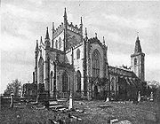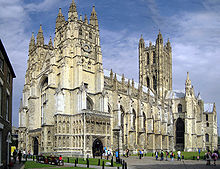
Geoffrey of Canterbury
Encyclopedia
Geoffrey was a twelfth-century Anglo-Norman
Benedictine
monk
and abbot
. Of Anglo-Norman
origin, he became monastic head of the Benedictine
priory
at Canterbury
, before moving to Scotland to be the first Abbot of Dunfermline
. As abbot he presided over the construction of the new monastery building, the immigration of English monks and settlers, and the accumulation of enough wealth to make Dunfermline Abbey the richest Benedictine monastic house in the Kingdom of Scotland
.
 He rose to prominence in the 1120s, becoming Prior
He rose to prominence in the 1120s, becoming Prior
of Christ Church Cathedral Priory sometime after the death of Prior Conrad on February 17, 1127. He held this position for little more than a year, until in 1128 he was invited to become the first Abbot of Dunfermline
, with the monastery of Dunfermline
recently being promoted from a priory to an abbey, being refounded with thirteen monks from Canterbury.
. Such influence had been established by Lanfranc
, Archbishop of Canterbury
, in the reign of King Máel Coluim mac Donnchada (1058–1093) via the latter's consort, the English princess Margaret of Wessex
. During the reign of King Alaxandair mac Maíl Choluim (1107–1124), there was an unsuccessful attempt to make Eadmer
, one of Christ Church's monks, Bishop of St Andrews. Now in the reign of King David I
(1124–1153), the Scottish monarchy was expanding the monastery at Dunfermline, and Geoffrey came to Scotland as part of royal plans to expand the size and promote the status of the house. Geoffrey was personally invited by the King of Scotland, who also sought and obtained the agreement of William de Corbeil
, the archbishop.
, Bishop of St Andrews, Geoffrey began his career as Dunfermline's abbot. During his abbacy, Geoffrey witnessed a great number of royal charter
s and King David persistently treated him with more respect that any other abbot — he was usually the first abbot to be named in any witness list. Despite initial problem with Causantín
, the local mormaer
, Geoffrey's abbacy was generally one of successful expansion of property in which numbers of English immigrants arrived to settle in and around the town of Dunfermline
. During his abbacy the abbey was transformed from a small church establishment into a large Romanesque
monastery, finally dedicated in 1150.
After this event in 1150, the abbot is not heard of again until the report of his death. The Chronicle of Holyrood recorded his death for the year 1154:
Anglo-Norman
The Anglo-Normans were mainly the descendants of the Normans who ruled England following the Norman conquest by William the Conqueror in 1066. A small number of Normans were already settled in England prior to the conquest...
Benedictine
Benedictine
Benedictine refers to the spirituality and consecrated life in accordance with the Rule of St Benedict, written by Benedict of Nursia in the sixth century for the cenobitic communities he founded in central Italy. The most notable of these is Monte Cassino, the first monastery founded by Benedict...
monk
Monk
A monk is a person who practices religious asceticism, living either alone or with any number of monks, while always maintaining some degree of physical separation from those not sharing the same purpose...
and abbot
Abbot
The word abbot, meaning father, is a title given to the head of a monastery in various traditions, including Christianity. The office may also be given as an honorary title to a clergyman who is not actually the head of a monastery...
. Of Anglo-Norman
Anglo-Norman
The Anglo-Normans were mainly the descendants of the Normans who ruled England following the Norman conquest by William the Conqueror in 1066. A small number of Normans were already settled in England prior to the conquest...
origin, he became monastic head of the Benedictine
Benedictine
Benedictine refers to the spirituality and consecrated life in accordance with the Rule of St Benedict, written by Benedict of Nursia in the sixth century for the cenobitic communities he founded in central Italy. The most notable of these is Monte Cassino, the first monastery founded by Benedict...
priory
Priory
A priory is a house of men or women under religious vows that is headed by a prior or prioress. Priories may be houses of mendicant friars or religious sisters , or monasteries of monks or nuns .The Benedictines and their offshoots , the Premonstratensians, and the...
at Canterbury
Canterbury
Canterbury is a historic English cathedral city, which lies at the heart of the City of Canterbury, a district of Kent in South East England. It lies on the River Stour....
, before moving to Scotland to be the first Abbot of Dunfermline
Abbot of Dunfermline
The Prior, then Abbot and then Commendator of Dunfermline was the head of the Benedictine monastic community of Dunfermline Abbey, Fife, Scotland. The abbey itself was founded in 1128 by King David I of Scotland, but was of earlier origin. King Máel Coluim mac Donnchada had founded a church there...
. As abbot he presided over the construction of the new monastery building, the immigration of English monks and settlers, and the accumulation of enough wealth to make Dunfermline Abbey the richest Benedictine monastic house in the Kingdom of Scotland
Kingdom of Scotland
The Kingdom of Scotland was a Sovereign state in North-West Europe that existed from 843 until 1707. It occupied the northern third of the island of Great Britain and shared a land border to the south with the Kingdom of England...
.
Canterbury

Prior
Prior is an ecclesiastical title, derived from the Latin adjective for 'earlier, first', with several notable uses.-Monastic superiors:A Prior is a monastic superior, usually lower in rank than an Abbot. In the Rule of St...
of Christ Church Cathedral Priory sometime after the death of Prior Conrad on February 17, 1127. He held this position for little more than a year, until in 1128 he was invited to become the first Abbot of Dunfermline
Abbot of Dunfermline
The Prior, then Abbot and then Commendator of Dunfermline was the head of the Benedictine monastic community of Dunfermline Abbey, Fife, Scotland. The abbey itself was founded in 1128 by King David I of Scotland, but was of earlier origin. King Máel Coluim mac Donnchada had founded a church there...
, with the monastery of Dunfermline
Dunfermline Abbey
Dunfermline Abbey is as a Church of Scotland Parish Church located in Dunfermline, Fife, Scotland. In 2002 the congregation had 806 members. The minister is the Reverend Alastair Jessamine...
recently being promoted from a priory to an abbey, being refounded with thirteen monks from Canterbury.
Canterbury and Dunfermline
Dunfermline was a daughter-house of Christ Church, while that Benedictine priory held significant influence in the Kingdom of ScotlandKingdom of Scotland
The Kingdom of Scotland was a Sovereign state in North-West Europe that existed from 843 until 1707. It occupied the northern third of the island of Great Britain and shared a land border to the south with the Kingdom of England...
. Such influence had been established by Lanfranc
Lanfranc
Lanfranc was Archbishop of Canterbury, and a Lombard by birth.-Early life:Lanfranc was born in the early years of the 11th century at Pavia, where later tradition held that his father, Hanbald, held a rank broadly equivalent to magistrate...
, Archbishop of Canterbury
Archbishop of Canterbury
The Archbishop of Canterbury is the senior bishop and principal leader of the Church of England, the symbolic head of the worldwide Anglican Communion, and the diocesan bishop of the Diocese of Canterbury. In his role as head of the Anglican Communion, the archbishop leads the third largest group...
, in the reign of King Máel Coluim mac Donnchada (1058–1093) via the latter's consort, the English princess Margaret of Wessex
Saint Margaret of Scotland
Saint Margaret of Scotland , also known as Margaret of Wessex and Queen Margaret of Scotland, was an English princess of the House of Wessex. Born in exile in Hungary, she was the sister of Edgar Ætheling, the short-ruling and uncrowned Anglo-Saxon King of England...
. During the reign of King Alaxandair mac Maíl Choluim (1107–1124), there was an unsuccessful attempt to make Eadmer
Eadmer
Eadmer, or Edmer , was an English historian, theologian, and ecclesiastic. He is known for being a contemporary biographer of his contemporary archbishop and companion, Saint Anselm, in his Vita Anselmi, and for his Historia novorum in Anglia, which presents the public face of Anselm...
, one of Christ Church's monks, Bishop of St Andrews. Now in the reign of King David I
David I of Scotland
David I or Dabíd mac Maíl Choluim was a 12th-century ruler who was Prince of the Cumbrians and later King of the Scots...
(1124–1153), the Scottish monarchy was expanding the monastery at Dunfermline, and Geoffrey came to Scotland as part of royal plans to expand the size and promote the status of the house. Geoffrey was personally invited by the King of Scotland, who also sought and obtained the agreement of William de Corbeil
William de Corbeil
William de Corbeil or William of Corbeil was a medieval Archbishop of Canterbury. Very little is known of William's early life or his family, except that he was born at Corbeil in the outskirts of Paris and that he had two brothers...
, the archbishop.
First Abbot of Dunfermline
After receiving a blessing by RobertRobert of Scone
Robert of Scone was a 12th century bishop of Cell Rígmonaid . Robert's exact origins are unclear. He was an Augustinian canon at the Priory of St. Oswalds, at Nostell...
, Bishop of St Andrews, Geoffrey began his career as Dunfermline's abbot. During his abbacy, Geoffrey witnessed a great number of royal charter
Charter
A charter is the grant of authority or rights, stating that the granter formally recognizes the prerogative of the recipient to exercise the rights specified...
s and King David persistently treated him with more respect that any other abbot — he was usually the first abbot to be named in any witness list. Despite initial problem with Causantín
Causantín, Earl of Fife
Causantín of Fife is the first man we know for certain to have been Mormaer of Fife. Causantín's floruit can be placed between 1095 and 1128. Very little is known about his life and reign as Mormaer of Fife. His father, for instance, is not known by name...
, the local mormaer
Mormaer
The title of Mormaer designates a regional or provincial ruler in the medieval Kingdom of the Scots. In theory, although not always in practice, a Mormaer was second only to the King of Scots, and the senior of a toisech.-Origin:...
, Geoffrey's abbacy was generally one of successful expansion of property in which numbers of English immigrants arrived to settle in and around the town of Dunfermline
Dunfermline
Dunfermline is a town and former Royal Burgh in Fife, Scotland, on high ground from the northern shore of the Firth of Forth. According to a 2008 estimate, Dunfermline has a population of 46,430, making it the second-biggest settlement in Fife. Part of the town's name comes from the Gaelic word...
. During his abbacy the abbey was transformed from a small church establishment into a large Romanesque
Romanesque architecture
Romanesque architecture is an architectural style of Medieval Europe characterised by semi-circular arches. There is no consensus for the beginning date of the Romanesque architecture, with proposals ranging from the 6th to the 10th century. It developed in the 12th century into the Gothic style,...
monastery, finally dedicated in 1150.
After this event in 1150, the abbot is not heard of again until the report of his death. The Chronicle of Holyrood recorded his death for the year 1154:
Geoffrey, the abbot of Dunfermline died; and his nephew Geoffrey succeeded in his place.His death was reported for June 9, 1154. Abbot Geoffrey was buried in the abbey.

